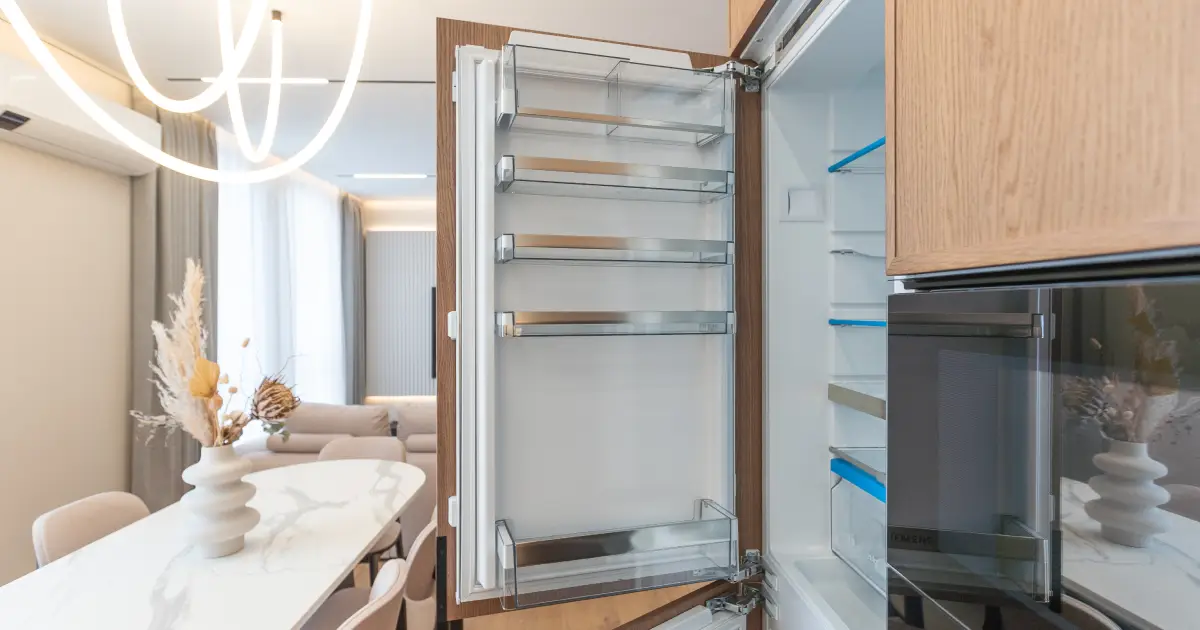When designing a modern kitchen, a built-in refrigerator is often the centerpiece that combines functionality with aesthetics. A built-in fridge not only serves as a high-end appliance but also integrates seamlessly with the rest of your kitchen’s design. In this article, we’ll explore what built-in refrigerators in Dubai are, how they differ from freestanding models, and the benefits of incorporating one into your kitchen.
What is a Built-In Refrigerator?
A built-in refrigerator is a custom-designed appliance that fits into a designated space within your kitchen cabinetry. Unlike freestanding models, which sit independently and can be moved around, built-in fridges are designed to be part of the kitchen’s architecture. They blend with the cabinetry, offering a more streamlined, polished appearance.
These refrigerators are typically larger than traditional models, allowing them to offer more storage space. They often come in various configurations, such as side-by-side, bottom freezer, or French door styles.
Key Differences Between Built-In and Freestanding Refrigerators
While both built-in and freestanding refrigerators serve the same purpose—keeping food cold—the way they fit into the kitchen environment makes them distinct.
- Design and Aesthetic Integration
Built-in refrigerators are designed to blend seamlessly with the rest of the cabinetry, giving your kitchen a sophisticated, cohesive look. The cabinetry is typically designed around the refrigerator, and it can be equipped with custom panels that match the kitchen’s style. In contrast, freestanding refrigerators are more noticeable and are typically not designed to blend into the kitchen layout. - Size and Capacity
Built-in refrigerators are typically larger and deeper than their freestanding counterparts. They are engineered to fit within standard cabinet dimensions and offer additional capacity. However, their depth often exceeds that of freestanding units, which can affect how they fit into smaller spaces. - Installation
A built-in refrigerator requires professional installation, as it needs to be secured within the cabinetry, making it a more complex and permanent choice. Freestanding refrigerators are easy to move and install, offering flexibility when redesigning your kitchen or relocating the appliance. - Cost
Built-in refrigerators tend to be more expensive than freestanding models. The cost can vary depending on the brand, size, features, and the complexity of the installation. However, the aesthetic and design appeal they bring to a kitchen often justify the additional investment for many homeowners.
Advantages of a Built-In Refrigerator
- Aesthetic Appeal
One of the biggest selling points of a built-in refrigerator is the sleek, integrated design. It provides a high-end, custom look that enhances the overall aesthetic of the kitchen. These fridges can be concealed with cabinetry panels that match the rest of your kitchen, making them virtually invisible. - Increased Storage Capacity
Built-in refrigerators offer generous storage space compared to their freestanding counterparts. They are designed with larger interior compartments, making them ideal for those who need to store large amounts of food or have a busy household. - Efficiency and Organization
Because built-in refrigerators are custom-designed, they often come with features that maximize space and improve organization. Adjustable shelving, door compartments, and specialized drawers can help organize different types of food, ensuring that everything has its place. - Long-Term Investment
Built-in refrigerators are typically built to last. Their higher upfront cost is offset by their durability and the value they add to a home. When designed to match other kitchen appliances, they increase the resale value of the property, making them a worthwhile investment. - Quiet Operation
Many built-in refrigerators are designed with quieter cooling systems. As these units are integrated into the cabinetry, the noise produced by the fridge is often minimized.
Considerations Before Choosing a Built-In Refrigerator
- Space Planning
Before purchasing a built-in refrigerator, it’s essential to evaluate your kitchen space. These units are large and require ample room for installation. You’ll need to measure the designated space carefully and consider any future kitchen remodels. - Customization Options
Allow you to match the fridge to your cabinetry’s color and design. Be sure to choose a fridge that offers the right level of customization if you want a perfectly coordinated look. - Ventilation
Adequate space around the fridge for airflow, and check the manufacturer’s installation instructions to ensure proper venting. - Maintenance and Repairs
While built-in refrigerators are durable, their complex installation means that repairs or maintenance may be more challenging. Always ensure that a professional can easily access the appliance for service if needed. - Cost of Installation
Cost of installation in your budget, in addition to the price of the fridge itself.
Top Features to Look for in a Built-In Refrigerator
- Smart Technology
Equipped with smart technology, allowing you to monitor and control the appliance remotely via smartphone apps. Some models even feature temperature adjustments, inventory tracking, and alerts for when your food is nearing its expiration date. - Energy Efficiency
With increasing energy costs, it’s important to select a refrigerator with an Energy Star rating. Built-in fridges are available in energy-efficient models, which help reduce your electricity bill while being environmentally friendly. - Dual Evaporators
Fridge and freezer have separate cooling systems, which helps to maintain optimal humidity and temperature control. This is particularly useful for keeping fruits and vegetables fresh for longer. - Adjustable Shelving and Drawers
Flexible shelving and organized drawers allow you to maximize storage space and adapt your fridge to different sizes of food items. - Water and Ice Dispensers
Built-in refrigerators often come with integrated water and ice dispensers, offering convenience and ease of access to chilled water and ice cubes, without the need for an external machine.
Conclusion
A built-in refrigerator is more than just an appliance—it’s a design element that elevates the functionality and style of your kitchen. Offering a sleek, integrated look and a high level of customization, these refrigerators are perfect for homeowners seeking a sophisticated, efficient kitchen setup. Though the initial investment and installation may be more costly than freestanding models, the long-term benefits make built-in refrigerators an excellent choice for many kitchens. When choosing a built-in fridge, consider your space, needs, and budget to ensure you select the right model for your home.











